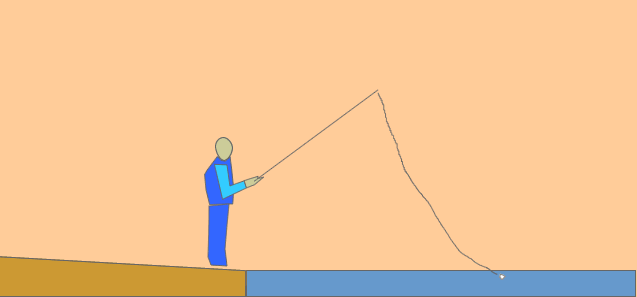A tuck cast is not just the leader and line "springing back." The flies have to spring back in a particular direction and location - Down and Back. Straight back will not do it, not will up and back. The Downward "spring" direction increases the force so the flies do not just drop down of their own weight but are DRIVEN down by the force of the rod recoil.
Here's an Orvis video on the tuck cast. View it first and then read my comments below. I have started the video where Pete Kutzer says to lift the rod. I will comment on that move later in this post but keep the lift in mind.
The Tuck cast should do 2 things. The fly should land first AND the fly should tuck under and back so that the leader lands upstream of the flies. The upstream position of the leader is what allows the nymph to sink free of the downstream drag of the leader and line.
The way to visualize a tuck cast is to think of it as an overpowered sidearm curve cast performed in the vertical plane rather than the horizontal plane. (See illustration of the sidearm curve cast at the end of this post) By overpowering the cast, the leader flips itself around and back under the fly line.
When the cast is done sidearm, there is no problem getting the fly and leader to curve around. But when you rotate that cast 90 degrees into the vertical, you need to allow enough space under the rod tip for that leader and fly to curve back
under the fly line.
You need to aim high enough to allow the fly to flip under and back. The Orvis Video does not mention that you need to aim high enough to allow the fly to flip under and back. If you aim too low the fly will hit the water before it can flip under the fly line/leader and land closer to you. If you find that your fly hits the water before flipping back, you can push the rod up and forward after the stop. This up and out mend creates the vertical space so that the fly can flip under the rod tip.
Here is Gary Borger demonstrating the tuck cast with a "lift" after "a Vertical Overpowered Curve Cast.
View attachment 34181
(When I could not get my tuck cast to work, I asked Gary Borger about it. He watched me cast and he told me an
important part of the cast that very few instructions emphasize.
The cast must be aimed high enough to give the cast the vertical distance and time to flip over. If you aim the cast in a downward trajectory (the typical high back cast, low forward cast), the cast will hit the water with a splash
before it can flip over and back toward the caster. Practice by aiming higher, and overpowering the cast.)
See the illustration below from Jason Borger's
Nature of Fly Casting. The tuck cast is the solid line.
Note that the tuck cast is in the "Overpowered Curve" module of Jason's modular teaching method. So remember that the Tuck Cast is a CURVE CAST in the DOWNWARD direction.
Notice that Jason's drawing shows the forward and slightly upward movement of the rod
after the rod stop (
--> F). This is a forward and upward mend that creates more vertical space for the cast to tuck. Notice that is not what the Orvis video tells you to do. He tells you to mend up after the stop. This gets the fly to drop BUT it does not help to get the fly to flip back and under.
So add the forward motion to the up motion in the video.
A true tuck cast gets the fly to flip under the rod and back toward you.
You saw in the Orvis video that the fly bounced back when he pulled the rod tip back and up. I disagree that you should not pull back on the rod tip. A pull back and up causes the fly to flip back and under. But you don't do it so hard that the fly flips all the way back to you. You need to fine tune that pull back.
I realize that some of the directions are contradictory, for example up and out vs back and up after the stop. They are different because the up and out is if you overpowered the cast enough to get the fly to flip under and back but did not provide the verticals space for this to occur. The back and up is if you did cast high enough but did not overpower the cast enough to flip back.
So examine what is going wrong if the cast does not do what it is supposed to do and do the mends (rod tip motion after the stop) to correct that.
If you are having a hard time doing the tuck cast, I suggest you practice is first as an
overpowered sidearm cast. Try the sidearm cast with the mends above to see how they affect the cast.
Once you can get that nymph to flip around and back on a side arm cast, then turn that cast vertically. Aim high enough to allow the flip back and under, or do the up and out mend after the hard stop.




